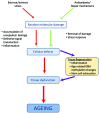Modelling the molecular mechanisms of aging
- PMID: 28096317
- PMCID: PMC5322748
- DOI: 10.1042/BSR20160177
Modelling the molecular mechanisms of aging
Abstract
The aging process is driven at the cellular level by random molecular damage that slowly accumulates with age. Although cells possess mechanisms to repair or remove damage, they are not 100% efficient and their efficiency declines with age. There are many molecular mechanisms involved and exogenous factors such as stress also contribute to the aging process. The complexity of the aging process has stimulated the use of computational modelling in order to increase our understanding of the system, test hypotheses and make testable predictions. As many different mechanisms are involved, a wide range of models have been developed. This paper gives an overview of the types of models that have been developed, the range of tools used, modelling standards and discusses many specific examples of models that have been grouped according to the main mechanisms that they address. We conclude by discussing the opportunities and challenges for future modelling in this field.
Keywords: aging; computational models; computer simulation; modelling standards; molecular mechanisms.
© 2017 The Author(s).
Conflict of interest statement
The authors declare that there are no competing interests associated with the manuscript.
Figures



References
-
- United Nations (2015) World Population Ageing, Department of Economic and Social Affairs Population Division, United Nations, New York: (ST/ESA/SER.A/390)
-
- Kirkwood T.B. (2005) Understanding the odd science of aging. Cell 120, 437–447 - PubMed
-
- Weinert B.T. and Timiras P.S. (2003) Invited review: theories of aging. J. Appl. Physiol. (1985) 95, 1706–1716 - PubMed
-
- Kowald A. and Kirkwood T.B.L. (1996) A network theory of ageing: the interactions of defective mitochondria, aberrant proteins, free radicals and scavengers in the ageing process. Mutat. Res. 316, 209–236 - PubMed
Publication types
MeSH terms
Substances
Grants and funding
LinkOut - more resources
Full Text Sources
Other Literature Sources
Medical
Research Materials

